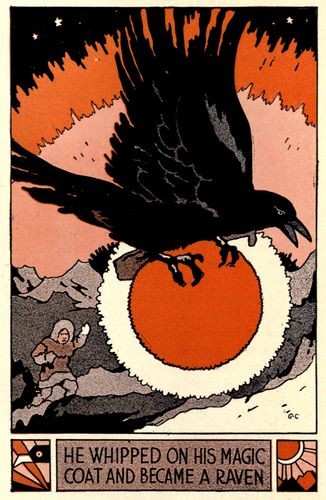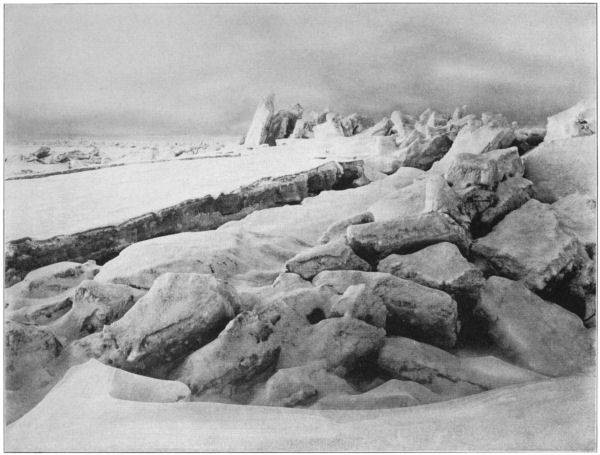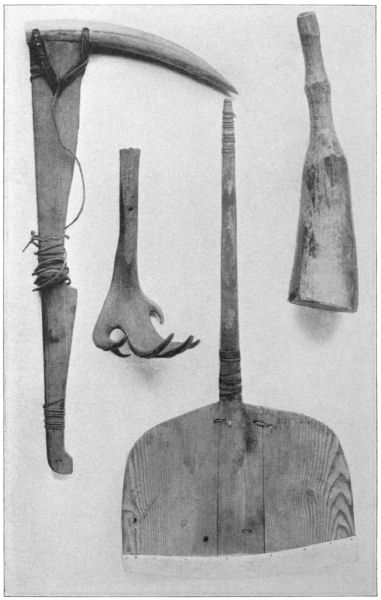This weekend the time shifts to Daylight Saving Time. Neither Standard time nor DST are perfect year round and so the debate about the time shift returns every year. This coming week has abnormally higher death and accident rates. Personally I'm NOT a Morning Person either way and will take a long time to adjust. Added to those problems, this autumn when the time again changes, people with pets inclined to wake them will find the shift back in time doesn't let them adjust to "fall back" after "springing forward."
The traditional tales from Alaska all tend to tell the same story, whether the many anthologies where Katherine Berry Judson includes it or the version by Clara K. Bayliss, calling the story "Chunks of Daylight" in her A Treasury of Eskimo Tales Judson shows the traditional tools from the holdings of the Smithsonian as an illustration. I'm going to include the illustration by George Carlson from the Bayliss book, but I prefer the extra bit of an ending Judson includes. Judson has several anthologies with the story, but this can be found at Project Gutenberg in The Myths and Legends of Alaska. Both Bayliss and Judson have this Raven be an orphan with a magic coat able to turn him into a Raven. I'm used to stories where Raven is a trickster and a bird and this story stays true to the trickster even if he doesn't start out as a Raven.
THE BRINGING OF THE LIGHT BY RAVEN
Eskimo (Lower Yukon)
IN the first days, the sun and moon were in the sky. Then the sun and moon were taken away and people had only the light of the stars. Even the magic of the shamans failed to bring back the light.
Now there was an orphan boy in the village who sat with the humble people over the entrance way of the kashim. He was despised by every one. When the magic of the shamans failed to bring back the sun and moon into the sky the boy mocked them. He said, “What fine shamans you must be. You cannot bring back the light, but I can.” Then the shamans were angry and beat that boy and drove him out of the kashim. Now this boy was like any other boy until he put on a raven coat he had. Then he became Raven.
Now the boy went to his aunt’s house. He told her the shamans had failed to bring back the light, and they had beaten him when he mocked them. The boy said, “Where are the sun and moon?”
The aunt said, “I do not know.”
The boy said, “I am sure you know. Look what a finely sewed coat you wear. You could not sew it that way if you did not know where the light is.”
Thus they argued.
Then the aunt said, “If you wish to find the light, go far to the south. Go on snowshoes. You will know the place when you get there.”
The boy put on his snowshoes and set off toward the south. Many days he travelled and the darkness was always the same. When he had gone a very long way he saw far in front of him a ray of light. Then the boy hurried on. As he went farther the light showed again, plainer than before. Then it vanished for a time. Thus it kept appearing and vanishing.
At last the boy came to a large hill. One side was brightly lighted; the other side was black as night. Close to the hill was a hut. A man was shovelling snow from in front of it. The man tossed the snow high in the air; then the light could not be seen until the snow fell. Then the man tossed the snow again. So the light kept appearing and disappearing. Close to the house was a large ball of fire.
The boy stopped and began to plan how to steal the ball of light.
Then the boy walked up to the man. He said, “Why do you throw up the snow? It hides the light from our village.”
The man said, “I am not hiding the light. I am cleaning away the snow. Who are you? Where did you come from?”
The boy said, “It is so dark at our village I do not want to stay there. I came here to live with you.”
“All the time?” asked the man.
“Yes,” said the boy.
The man said, “All right. Come into the house with me.” Then he dropped his shovel on the ground. He stooped down to lead the way through the underground passage into the house. He let the curtain fall in front of the door as he passed, because he thought the boy was close beside him.
Then the boy caught up the ball of light. He put it in the turned-up flap of his fur coat. Then he picked up the shovel and ran away toward the north. He ran until his feet were tired. Then he put on his raven coat and flew away. He flew rapidly to the north. Raven could hear the man shriek behind him. The man was pursuing him. But Raven flew faster. Then the man cried, “Keep the light; but give me my shovel.”
Raven said, “No, you cannot have your shovel. You made our village dark.” So Raven flew faster.
Now as Raven flew, he broke off a little piece of the light. This made day. Then he went on a long time in darkness, until he broke off another piece of light. Thus it was day again. So as Raven flew to the village he broke off the pieces of light. When Raven reached the kashim of his own village he threw away the last piece. He went into the kashim and said to the shamans, “I have brought back the light. It will be light and then dark, so as to make day and night.”
After this Raven went out upon the ice because his home was on the seacoast. Then a great wind arose, and the ice drifted with him across the sea to the land on the other side.
Thus Raven brought back the light. It is night and day, as he said it would be. But sometimes the nights are very long because Raven travelled a long way without throwing away a piece of the light.
**** I'm also a fan of the way Caldecott award winning artist, Gerald McDermott, handles the story in his book, Raven; A Trickster Tale from the Pacific Northwest.
**** May our chunks of daylight be longer and longer for the coming months.
This is part of a series of postings of stories under the category, "Keeping the Public in Public Domain." The idea behind Public Domain was to preserve our cultural heritage after the authors and their immediate heirs were compensated. I feel strongly current copyright law delays this intent on works of the 20th century. My own library of folklore includes so many books within the Public Domain I decided to share stories from them. I hope you enjoy discovering new stories.
At the same time, my own involvement in storytelling regularly creates projects requiring research as part of my sharing stories with an audience. Whenever that research needs to be shown here, the publishing of Public Domain stories will not occur that week. This is a return to my regular posting of a research project here. (Don't worry, this isn't dry research, my research is always geared towards future storytelling to an audience.) Response has convinced me that "Keeping the Public in Public Domain" should continue along with my other postings as often as I can manage it.
Other Public Domain story resources I recommend-
There are many online resources for Public Domain stories, maybe none for folklore is as ambitious as fellow storyteller, Yoel Perez's database, Yashpeh, the International Folktales Collection. I have long recommended it and continue to do so. He has loaded Stith Thompson's Motif Index into his server as a database so you can search the whole 6 volumes for whatever word or expression you like by pressing one key. http://folkmasa.org/motiv/motif.htm
You may have noticed I'm no longer certain Dr. Perez has the largest database, although his offering the Motif Index certainly qualifies for those of us seeking specific types of stories. There's another site, FairyTalez claiming to be the largest, with "over 2000 fairy tales, folktales, and fables" and they are "fully optimized for phones, tablets, and PCs", free and presented without ads.
Between those two sites, there is much for story-lovers, but as they say in infomercials, "Wait, there's more!"




No comments:
Post a Comment